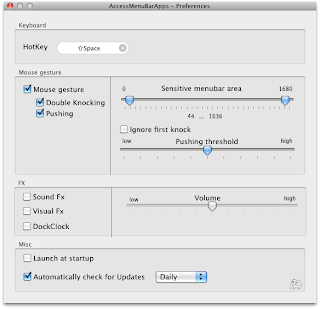At a Glance

Expert’s Rating

Cons
AccessMenuBarApps removes the problem of viewing menu bar icons on laptop displays. This utility allows you to expand your menu bar when you need it. AccessMenuBarApps For Mac是一款macOS平台的让菜单栏图标更好安排更好用的软件,当我们在Mac上开发一些软件的时候,很多软件的功能菜单会占用菜单条左侧较大区域的软件,往往会将你菜单栏右侧的项目图标挡住,非常的不方便,这款工具的目的就是来解决这个问题.
Our Verdict
- Always On Scroll Bars in Lion, 'New' Mac Pro Same as the Old Mac Pro, and More, Mac News Review, 2012.06.29. Run Classic Mac software with SheepShaver, Kensington security products for iMacs, iAntivirus updated, and more.
- AccessMenuBarApps for Mac. By Ortisoft Free. Developer's Description. By Ortisoft In the right side of the menubar there are a lots of more ore less usefull apps, like time machine.
- AccessMenuBarApps Mac cracked version – is a macOS platform to let the menu bar icon Better arrange and use Mac cracked app. When we develop some Mac cracked app on the Mac, the function menus of many Mac cracked app will occupy a larger area of the Mac cracked app on the left side of the menu bar, often blocking the item icons on the right side of your menu bar, which is very Inconvenient.
It seems as though recently, more and more useful apps are opting to stick an icon in the menu bar rather than add an icon to the Dock. Line for mac pc. On my main Mac, between a few of Apple’s own menu extras and a slew of third-party utilities, I’ve got 22 icons on the right-hand side of my menu bar, and they’re all things I use daily.
The drawback to this approach, of course, is that once you get enough systemwide menu-bar icons, the menus of traditional apps start to cover them up. This is especially the case on smaller-screened laptops, such as the MacBook Air. The workaround is to switch to an application that doesn’t have as many menus—for example, the Finder. But if you have enough stuff up there, even apps with few menus cover up some of the icons.

Back in late 2010, I covered NoMenuBar, a simple utility that does nothing except give you an app with a single menu—when you switch to NoMenuBar, it leaves plenty of room for menu-bar utilities. But a drawback of NoMenuBar is that since it’s a traditional application, you must click its icon in the Dock, or use OS X’s Command-Tab application switcher, to activate it.
An alternative with a few more options is AccessMenuBarApps. Like NoMenuBar, AccessMenuBarApps is designed to display only a single menu, although in this case, that menu is even smaller—it’s just a little Yin/Yang icon. But AccessMenuBarApps provides a number of additional ways to activate it. You can, of course, click its icon in the Dock or use the Command-Tab application switcher. (Oddly, AccessMenuBarApps adds its own menu to the menu bar, which you can also click—you can’t disable this icon.) But you can also activate AccessMenuBarApps with a customizable keyboard shortcut or—perhaps the easiest method—by simply moving the pointer to the top of the screen.

To keep this last action from activating AccessMenuBarApps whenever you want to access a menu or menu-bar icon, the program requires you to perform either of two gestures. The first is to bump the pointer against the top edge of your screen twice in quick succession. This sounds a bit odd, but it works well in practice—you just bump-bump quickly against the top of the screen, and when all your menu-bar icons are uncovered, the pointer is conveniently positioned to click one. The second gesture requires you to bump the pointer against the top edge of the screen and then continue pushing it up; AccessMenuBarApps activates after you’ve pushed a certain distance (configurable in the app’s preferences).
Whether you choose double-bumping, pushing, or both, you can also choose whether these gestures work across the entire menu bar, or just a specific section of it. AccessMenuBarApps’ preferences window displays a slider with a pixel range equal to the horizontal size of your display (in the case of my 27-inch iMac, from 0 to 2560); you just choose lower and upper boundaries for the target area—for example, on my iMac, 1648 to 2560 is roughly equal to the section of the menu bar containing all my menu-bar icons. A nice touch is that these mouse gestures work even when you’re dragging files or content, so if you’ve got menu-bar utilities that support drag and drop, you can use AccessMenuBarApps to reveal those icons during a drag operation.
To help you get the hang of AccessMenuBarApps, the utility provides sound effects whenever you bump or push against the top of the screen; it also displays visual feedback in the form of a purple bar along the top of the screen whenever you perform a gesture. Iphone 4 jailbreak for mac. Once you get used to using AccessMenuBarApps, you can disable either or both of these. (At least in theory—I haven’t been able to completely disable audio feedback without disabling visual feedback.)

Accessmenubarapps Macos
Just as you can’t disable the program’s menu-bar icon, you can’t disable its Dock icon. But at least the developer has made the latter icon useful or entertaining: You can choose to have it display an animated clock or an Eyeballs-like set of eyes that follow the pointer around the screen. Best player music for mac.
Thanks to AccessMenuBarApps’ multiple methods for activation, it feels less like a one-menu app that you switch to in order to see all your menu-bar icons, and more like a nifty utility that provides a number of ways to view your full menu bar.
Accessmenubarapps
Want to stay up to date with the latest Gems? Sign up for the Mac Gems newsletter for a weekly email summary of Gems reviews sent directly to your Inbox. You can also follow Mac Gems on Twitter.
